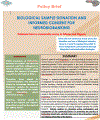Communicating the ethical, legal, and social issues in neurobiobanking and stroke genomic research in Africa: Project intervention tools development and evaluation procedures
- PMID: 40523418
- PMCID: PMC12369658
- DOI: 10.1016/j.jstrokecerebrovasdis.2025.108378
Communicating the ethical, legal, and social issues in neurobiobanking and stroke genomic research in Africa: Project intervention tools development and evaluation procedures
Abstract
Background and aim: Issues concerning appropriate Community Engagement (CE) and communication of research outcomes with stakeholders have received the attention of scholars in different sub-fields of clinical research. However, given its novel nature, especially in Sub-Saharan Africa, CE addressing the ethical, legal, and social implications (ELSI) of neurobiobanking and stroke genomic research has not received much scholarly attention. Therefore, this study was designed as a pioneering effort to report the procedures for developing and evaluating intervention tools for the CE component of the African Neurobiobank for Precision Stroke Medicine ELSI Project.
Methods: A community-based participatory research design was adopted. The intervention tools we developed include general advocacy, educative, and training videos focusing on neurobiobanking, stroke genomics and precision stroke medicine in Africa; infographics; and a policy brief. An adapted Doak and Doak's Suitability Assessment Measure (SAM), the Agency for Healthcare Research and Quality (AHRQ) Patient Education Materials Assessment Tool (PEMAT), and semi-structured interview questions based on Willis' Cognitive Interviewing Techniques were used to evaluate the suitability, actionability, understandability and cultural appropriateness of the tools.
Results: PEMAT mean percentage scores of 71.4 % for actionability and 82.4 % for understandability, and a SAM suitability score of 67.9 % were reported for the videos. Identified weaknesses captured in seven thematic areas after assessment analysis by experts and community members guided the final refinement of the tools.
Conclusion: The overall reviewers' reports and evaluation scores indicate that the intervention tools are generally suitable for community deployment in sub-Saharan Africa. Clinical researchers must partner with key stakeholders, define policy objectives and desired behaviour change, and develop appropriate persuasive communication strategies and tools for community engagement.
Keywords: Community Engagement; Community-Based Participatory Research, ELSI; Health Literacy; Neurobiobanking in Africa; Persuasive Communication; Precision Stroke Medicine.
Copyright © 2025 The Authors. Published by Elsevier Inc. All rights reserved.
Conflict of interest statement
Declaration of competing interest The authors acknowledge receipt of the following financial support for the research, authorship, and/or publication of this article: The African Neurobiobank for Precision Stroke Medicine ELSI Project, the SIREN Study, and the Systematic Investigation of Blacks with Stroke using Genomics (SIBS Genomics) Study are supported by Grants U01HG010273, U54HG007479, and R01NS107900, respectively, from the National Institutes of Health as part of the H3Africa Consortium. The corresponding author Rufus O. Akinyemi is further supported by the fellowship FLAIR FLR/R1/191813, FCG/R1/201034) funded by the UK Royal Society and the African Academy of Sciences and the Alzheimer Association and Global Brain Health Institute (GBHI ALZ UK-21- 24204). However, we declare that we have no known competing financial interests, obligations or personal relationships with any individuals or institutions that could potentially compromise or influence the work reported in this article.
Figures




References
-
- Abimiku A, et al. , H3Africa Biorepository Program: Supporting genomics research on African populations by sharing high-quality biospecimens. Biopreservation and Biobanking, 2017. 15(2): p. 99–102.
-
- Mayne ES, et al. , Genes for Life: Biobanking for Genetic Research in Africa. Biopreservation and Biobanking, 2017. 15(2): p. 93–94.
-
- Akinyemi RO, et al. , Unraveling the Ethical, Legal, and Social Implications of Neurobiobanking and Stroke Genomic Research in Africa: A Study Protocol of the African Neurobiobank for Precision Stroke Medicine ELSI Project. International Journal of Qualitative Methods, 2020. 19: p. 160940692092319. - PMC - PubMed
MeSH terms
Grants and funding
LinkOut - more resources
Full Text Sources
Medical

